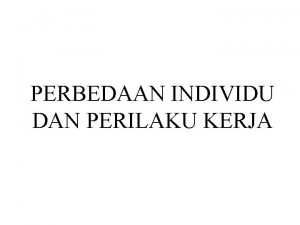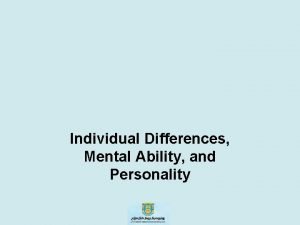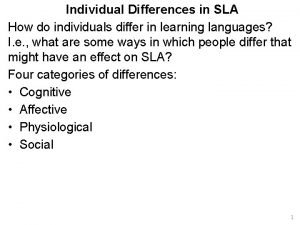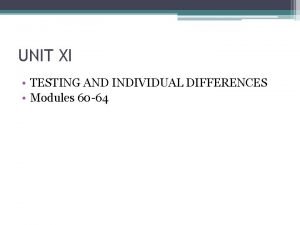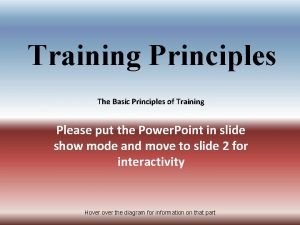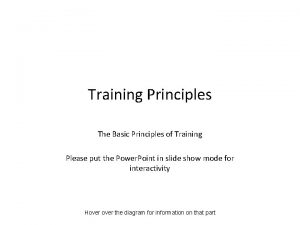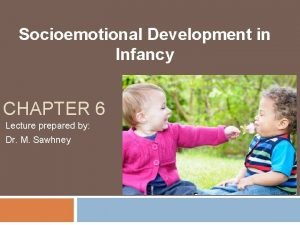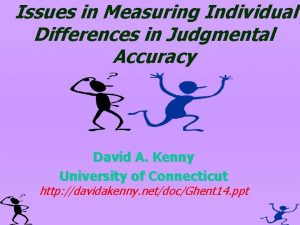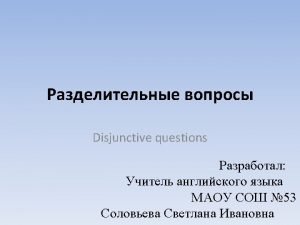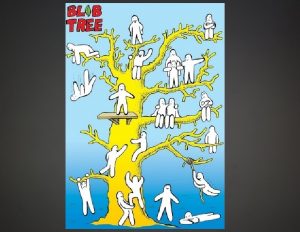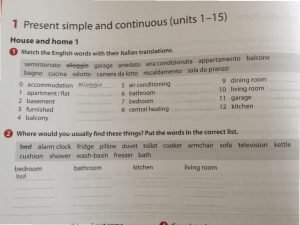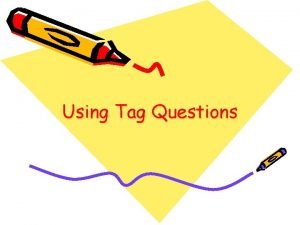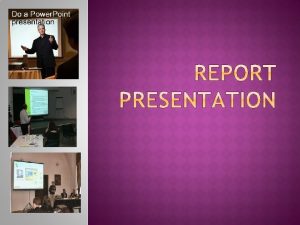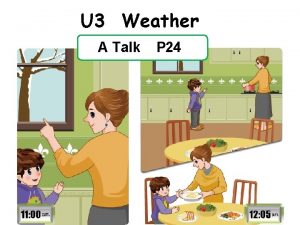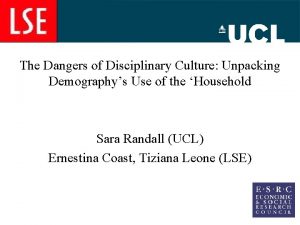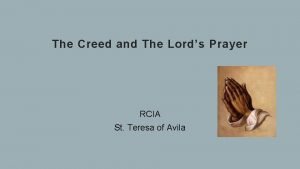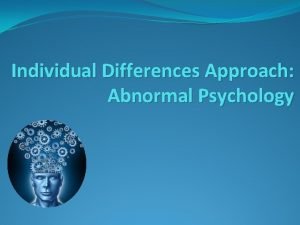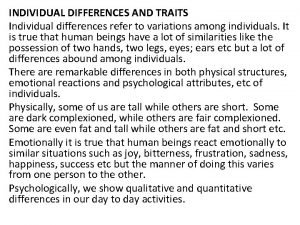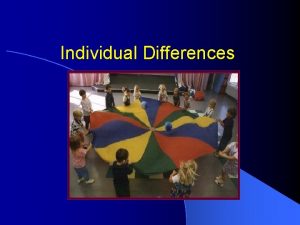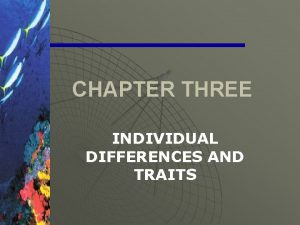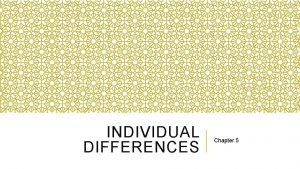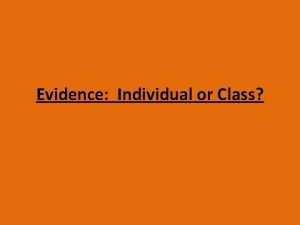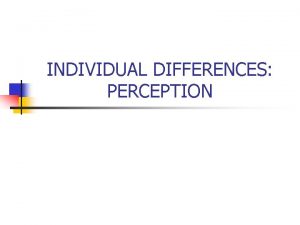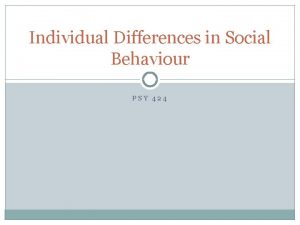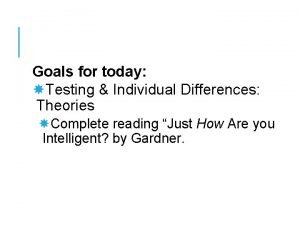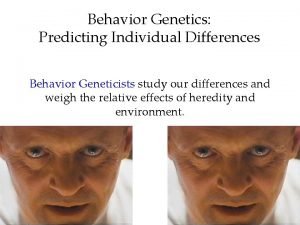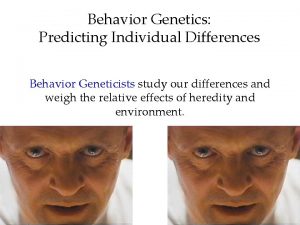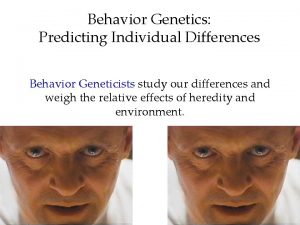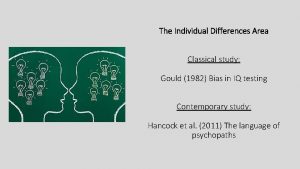Individual differences Today A study in how differences















































- Slides: 47

Individual differences Today: • A study in how differences in thinking style affect problem solving – Evidence that differences in thinking style are linked to problem solving performance etc. • First: a test of thinking style!

Part 1 – word association • 6 sets of words – 1 target word, and 4 other words • Which of the 4 other words do you most associate with the target word? – Example: House • number, street, flat, room – Write your answer on the data sheet • Try to be as quick and honest as possible


Book letter, library, paper, couch


Tree leaf, forest, roots, fire


Computer software, office, monitor, hard-disk


Spoon metal, soup, fork, dinner


Bird garden, feather, song, eagle


Music orchestra, note, dance, violin


Part 2 – number association • 6 sets of numbers – 1 target number, and 4 other numbers • Which of the 4 other numbers do you most associate with the numbers? – Example: 33 • 30, 66, 3, 35 – Write your answer on the data sheet • Try to be as quick and honest as possible


1 0, 11, 2, -1


301 302, 31, 299, 602


54 55, 27, 50, 108


16 32, 4, 256, 8


1000 100, 1001, 999, 2000


98 99, 100, 97, 49


Individual differences • People vary in all sorts of ways • Study of individual differences – Along which dimensions do people differ? • Intelligence • Personality • Thinking style – What do these differences predict? • Problem solving? – Spatial reasoning? – Logical sequencing?

Thinking styles • Two groups in the population: – Inductive thinkers – Deductive thinkers • Not really about accuracy in judgement – Impossible on the association tasks! – Assesses default thinking style – how people approach problems, tasks, etc. • Roughly 50/50 split in population

Thinking styles • Inductive thinkers and deductive thinkers are not just different • Thinking style has been shown to predict: – Performance in problem solving tasks • Speed and accuracy in spatial reasoning; logical sequencing etc. • A robust difference – Observed in many contexts

Crozier, J. , & Johnson, P. (2008). A meta-analysis of thinking style and problem solving performance. Psychological Bulletin, 106, 345 -373. 80 75 70 65 60 Average performance on spatial reasoning tasks (%) 55 50 45 40 35 Trial Trial 1 2 3 4 5 6 Number of repeated trials

Crozier, J. , & Johnson, P. (2008). A meta-analysis of thinking style and problem solving performance. Psychological Bulletin, 106, 345 -373. 80 75 70 65 Average performance on logical sequencing tasks (%) 60 55 50 45 40 Trial Trial 1 2 3 4 5 6 Number of repeated trials

Thinking styles • Is the difference stable (hard to change)? – Yes! • The effect of thinking style is relatively ‘fixed’, and it is very difficult to close the gap in performance between the groups • Intervention and collaboration? • Rest of the lab: Problem solving tasks


Crozier, J. , & Johnson, P. (2008). A meta-analysis of thinking style and problem solving performance. Psychological Bulletin, 106, 345 -373. 80 75 70 65 60 Average performance on spatial reasoning tasks (%) 55 50 Inductive thinkers 45 Deductive thinkers 40 35 Trial Trial 1 2 3 4 5 6 Number of repeated trials

Crozier, J. , & Johnson, P. (2008). A meta-analysis of thinking style and problem solving performance. Psychological Bulletin, 106, 345 -373. 80 Inductive thinkers 75 Deductive thinkers 70 65 Average performance on logical sequencing tasks (%) 60 55 50 45 40 Trial Trial 1 2 3 4 5 6 Number of repeated trials

Thinking styles • Is the difference stable (hard to change)? – Yes! • The effect of thinking style is relatively ‘fixed’, and it is very difficult to close the gap in performance between the groups • Intervention and collaboration? • Rest of the lab: Problem solving tasks


Debrief 1. The inductive thinker/deductive thinker distinction is not real! – You were allocated to groups at random, regardless of your estimates 2. There is no link between ‘thinking styles’ and problem solving ability etc. ! – This information was intended to create a status difference between the groups (one better than the other)

Debrief 3. The ‘message’ from the other group was not real! – It was pre-prepared – Designed to see how group members react • Conflict, or no conflict? So what is the real purpose of the lab…? • To examine the effects of categorisation and group status on perceptions of conflict

Intergroup behaviour • Importance of categorisation – Psychological distinction between ‘us’ and ‘them’ • The ‘minimal group’ studies (e. g. , Tajfel et al. , 1971) – Participants categorised on apparently meaningless basis • Coin toss; perceptual style; painter preference – Asked to allocate points/money to anonymous members of their group and the outgroup – Typical finding: discrimination emerges in the allocations • People give more to the ‘ingroup’ member than the outgroup member

Intergroup behaviour • Implication: mere categorisation is enough for discrimination to emerge • BUT what about inequality between groups? – Intergroup status differences • This study: – Categorisation + intergroup status difference – Do high- and low-status groups perceive conflict to the same extent?

Intergroup behaviour • Why might group status affect perceptions of conflict with another group? • Two possibilities: – Some research shows that high-status groups show more ingroup bias, discrimination than lowstatus groups (e. g. , Bettencourt et al. , 2001) – Hypothesis: High-status groups will perceive more conflict than low-status groups

Intergroup behaviour • Why might group status affect perceptions of conflict with another group? • Two possibilities: – Low-status groups -> want to improve their group’s status by challenging the outgroup – High-status groups -> want to keep the status difference intact by reducing conflict – Hypothesis: High-status groups will perceive less conflict than low-status groups

Reflection… • Did you believe the division to be real? • How did the inductive thinkers (the high-status group) feel, and how did the deductive thinkers (the low-status group) feel – especially when you learned about the status difference, and when the deductive thinkers had to leave the room? • Did you care which group you were in? • Did you have any particular thoughts or feelings about the other group? • Did you have any particular feelings about the experimenter? • What did you think and feel when the message from the other group was read out?
 For today's meeting
For today's meeting How was today's class
How was today's class Meeting objective
Meeting objective Today lesson or today's lesson
Today lesson or today's lesson Today's lesson or today lesson
Today's lesson or today lesson Example of repitition
Example of repitition Managing individual differences and behavior
Managing individual differences and behavior Proactive personality
Proactive personality Individual differences in second language learning
Individual differences in second language learning Individual differences factors
Individual differences factors Perbedaan individu dalam organisasi
Perbedaan individu dalam organisasi Individual differences in workplace
Individual differences in workplace Individual differences factors
Individual differences factors Individual differences in sla
Individual differences in sla Unit xi testing and individual differences
Unit xi testing and individual differences Basic principle of training
Basic principle of training Principles of training individual differences
Principles of training individual differences Involves individual differences in behavioral styles
Involves individual differences in behavioral styles Conclusion of individual differences
Conclusion of individual differences Growth and development definition
Growth and development definition What is case series
What is case series Retrospective cohort study
Retrospective cohort study Work study technique
Work study technique Study less study smart
Study less study smart Phytogeographical regions of world
Phytogeographical regions of world Objectives of work study
Objectives of work study Differentiate between time study and motion study
Differentiate between time study and motion study Kachru three circle model limitations
Kachru three circle model limitations Is anyone absent today
Is anyone absent today Feel like a blob
Feel like a blob How did you finish your homework
How did you finish your homework What the weather like today
What the weather like today Weird true and freaky
Weird true and freaky She is beautiful question tag
She is beautiful question tag Dear ladies and gentlemen
Dear ladies and gentlemen Today weather
Today weather Romeo juliet introduction
Romeo juliet introduction Introduction to romeo and juliet
Introduction to romeo and juliet The world today part 1
The world today part 1 Weather report script today
Weather report script today Olongman
Olongman 1260 days in years
1260 days in years Originalmarkz youtube
Originalmarkz youtube Nicolaitans today
Nicolaitans today Take charge today the fundamentals of investing
Take charge today the fundamentals of investing Davidian today
Davidian today Hill 875 today
Hill 875 today Our father creed
Our father creed











